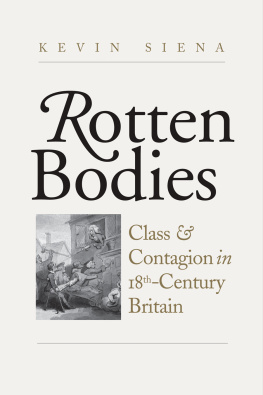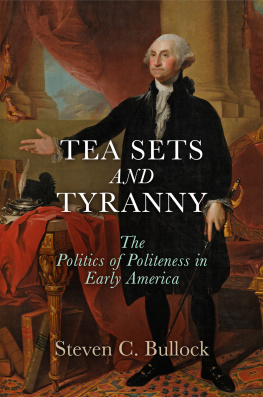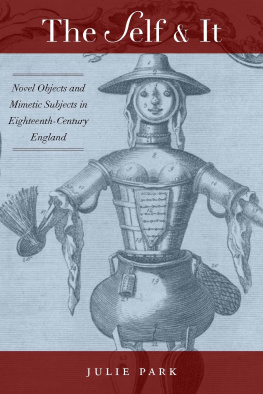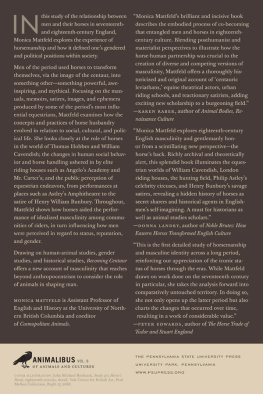Alun Withey - Technology, Self-Fashioning and Politeness in Eighteenth-Century Britain: Refined Bodies
Here you can read online Alun Withey - Technology, Self-Fashioning and Politeness in Eighteenth-Century Britain: Refined Bodies full text of the book (entire story) in english for free. Download pdf and epub, get meaning, cover and reviews about this ebook. year: 2015, publisher: Palgrave Pivot, genre: Religion. Description of the work, (preface) as well as reviews are available. Best literature library LitArk.com created for fans of good reading and offers a wide selection of genres:
Romance novel
Science fiction
Adventure
Detective
Science
History
Home and family
Prose
Art
Politics
Computer
Non-fiction
Religion
Business
Children
Humor
Choose a favorite category and find really read worthwhile books. Enjoy immersion in the world of imagination, feel the emotions of the characters or learn something new for yourself, make an fascinating discovery.
- Book:Technology, Self-Fashioning and Politeness in Eighteenth-Century Britain: Refined Bodies
- Author:
- Publisher:Palgrave Pivot
- Genre:
- Year:2015
- Rating:3 / 5
- Favourites:Add to favourites
- Your mark:
- 60
- 1
- 2
- 3
- 4
- 5
Technology, Self-Fashioning and Politeness in Eighteenth-Century Britain: Refined Bodies: summary, description and annotation
We offer to read an annotation, description, summary or preface (depends on what the author of the book "Technology, Self-Fashioning and Politeness in Eighteenth-Century Britain: Refined Bodies" wrote himself). If you haven't found the necessary information about the book — write in the comments, we will try to find it.
Alun Withey: author's other books
Who wrote Technology, Self-Fashioning and Politeness in Eighteenth-Century Britain: Refined Bodies? Find out the surname, the name of the author of the book and a list of all author's works by series.
Technology, Self-Fashioning and Politeness in Eighteenth-Century Britain: Refined Bodies — read online for free the complete book (whole text) full work
Below is the text of the book, divided by pages. System saving the place of the last page read, allows you to conveniently read the book "Technology, Self-Fashioning and Politeness in Eighteenth-Century Britain: Refined Bodies" online for free, without having to search again every time where you left off. Put a bookmark, and you can go to the page where you finished reading at any time.
Font size:
Interval:
Bookmark:
Technology, Self-Fashioning and Politeness in Eighteenth-Century Britain
Also by Alun Withey
PHYSICK AND THE FAMILY: Health, Medicine and Care in Wales, 16001750 (Manchester: Manchester University Press, 2011).
* Winner of European Association for the History of Medicine and Health (EAHMH) book prize, 2013

Technology, Self-Fashioning and Politeness in Eighteenth-Century Britain: Refined Bodies
Alun Withey
Wellcome Research Fellow, University of Exeter, UK


TECHNOLOGY, SELF-FASHIONING AND POLITENESS IN EIGHTEENETH- CENTURY BRITAIN
Copyright Alun Withey, 2016.
All rights reserved. No reproduction, copy or transmission of this publication may be made without written permission.
No portion of this publication may be reproduced, copied or transmitted save with written permission. In accordance with the provisions of the Copyright, Designs and Patents Act 1988, or under the terms of any licence permitting limited copying issued by the Copyright Licensing Agency, Saffron House, 610 Kirby Street, London EC1N 8TS.
Any person who does any unauthorized act in relation to this publication may be liable to criminal prosecution and civil claims for damages.
First published 2016 by
PALGRAVE MACMILLAN
The author has asserted their right to be identified as the author of this work in accordance with the Copyright, Designs and Patents Act 1988.
Palgrave Macmillan in the UK is an imprint of Macmillan Publishers Limited, registered in England, company number 785998, of Houndmills, Basingstoke, Hampshire, RG21 6XS.
Palgrave Macmillan in the US is a division of Nature America, Inc., One New York Plaza, Suite 4500 New York, NY 100041562.
Palgrave Macmillan is the global academic imprint of the above companies and has companies and representatives throughout the world.
Hardback ISBN: 9781137467478
E-PUB ISBN: 9781137467485
E-PDF ISBN: 9781137467485
DOI: 10.1057/9781137467485
Distribution in the UK, Europe and the rest of the world is by Palgrave Macmillan, a division of Macmillan Publishers Limited, registered in England, company number 785998, of Houndmills, Basingstoke, Hampshire RG21 6XS.
Library of Congress Cataloging-in-Publication Data is available from the Library of Congress
A catalog record for this book is available from the Library of Congress
A catalogue record for the book is available from the British Library
Contents
List of Figures
Preface
In the eighteenth century, expectations of bodily appearance changed. Cultural changes, including the rise of polite behaviours and deportment, meant that managing the body was increasingly requisite in order to meet changing social expectations of appearance. In came new aesthetic ideals including smooth skin, neatness and harmony, symmetry, form and concepts of a natural body. An increasing number of arenas, from coffee houses to civic and society events also brought new opportunities for bodily appearance to be scrutinised.
To cater for changing expectations of bodily appearance, a range of instruments, objects and practices became invested with new meaning. All manner of devices were used to alter everything from the minutiae of self-fashioning to the very shape and form of the corporeal fabric. Razors helped men achieve the clean-shaven masculine ideal. Tweezers, nail nippers and toothpicks all played an important role in cleaning, honing and perfecting bodily surfaces. A variety of machines and instruments helped adults and children mould their bodies towards a natural shape, and to correct and conceal deformities or disabilities.
At the same time, technological developments in the second half of the eighteenth century, most notably in steel, brought changes to what was materially possible in terms of fashioning the body. In many ways it was arguably the enlightened metal, and almost certainly the industrial output with which people had the most intimate physical contact. Steel, for example, transformed the manufacture of razors, which became sharper, more durable and arguably more aesthetically appealing. The tensile, springy strength of cast steel was utilised by specialist makers of postural devices to force the body into the desired shape. It was a key component in the majority of devices discussed in this book, and makers often trumpeted its use in their products.
Despite the apparent emphasis upon innovation and the impact of a new technology, this study is not a straightforward story of change nor, especially, of triumphant progress. At its heart, however, it is a story of refinement and improvement in the broadest sense. Each chapter explores a different instrument, or set of instruments, and demonstrates the often-intricate relationship that existed between form and function, technology and culture. The pace of change differed in each case, and various instruments came to prominence or popularity at different times. Changes to spectacles, for example, were discernible before 1750 and continued beyond 1800. The razor-making trade began to be transformed around the mid-century. Developments in surgical instrument manufacture and retail, however, were more prominent at the end of the century. Most instruments discussed here also follow a different trajectory in terms of the bodily expectations to which they were applied. Razors spoke to masculine ideals of the smooth, clean-shaven face. Personal grooming instruments, such as toothpicks and nail nippers, were a response to new emphases laid upon the appearance of specific areas of the body in public. Further, the relationship between form and function is often subtle, and the interplay between technology and culture difficult to separate. Steel, for example, allowed changes to the design of spectacles, but this occurred at the same time as they began to become associated with learning and sagacity, rather than deficiency. Even surgical instruments, to some degree transformed by steel, were not part of what might be viewed as domestic consumption, but they were nevertheless important vectors for changes to bodily form.
In the last analysis, all objects and practices are historically contingent. The eighteenth century was a period in which all manner of devices were invested with new meaning as vectors through which people sought to manage, refine and even transform, their appearance. In many cases, these were quotidian objects rather than trophy possessions like clothing, watches or jewellery. If we are to capture the totality of experiences, it is necessary to engage with the everyday, the quotidian and the mundane as well as the elaborate and luxurious. It is to these ends that this book aspires.
Acknowledgements
The creation of this book owes much to the countless contributions made by colleagues and friends over the past few years.
Perhaps the biggest debt of gratitude is owed to Chris Evans, who first inspired my interest in the history of steel during my tenure as research fellow on his project Steel in Britain in the Age of Enlightenment at the University of South Wales. His generosity in allowing me to appropriate part of the material from that project is matched by his continuing support, advice and encouragement for my work.
The book was written whilst I have been a Research Fellow at Exeter University, working on the Wellcome Trust project The Medical World of England, Wales and Ireland, 15501715, under the guidance and supervision of Jonathan Barry and Peter Elmer. It is a tribute to their patience, forbearance and willingness to invest in the career development of their team that this book could be written at all. Jonathan has also read and provided incisive and valuable comments upon many draft chapters, which have helped immeasurably in shaping the book, for which I am extremely grateful. My colleagues Justin Colson, John Cunningham and Hannah Murphy all provided friendly and helpful advice in our many meetings. I also particularly thank Margaret Pelling for encouraging me to complete the book, and giving me the confidence to do so when it looked in danger of losing direction. The History Department at Exeter and the Centre for the History of Medicine have provided a friendly, collegial and supportive atmosphere in which to work, and I am proud to be their colleague.
Next pageFont size:
Interval:
Bookmark:
Similar books «Technology, Self-Fashioning and Politeness in Eighteenth-Century Britain: Refined Bodies»
Look at similar books to Technology, Self-Fashioning and Politeness in Eighteenth-Century Britain: Refined Bodies. We have selected literature similar in name and meaning in the hope of providing readers with more options to find new, interesting, not yet read works.
Discussion, reviews of the book Technology, Self-Fashioning and Politeness in Eighteenth-Century Britain: Refined Bodies and just readers' own opinions. Leave your comments, write what you think about the work, its meaning or the main characters. Specify what exactly you liked and what you didn't like, and why you think so.








